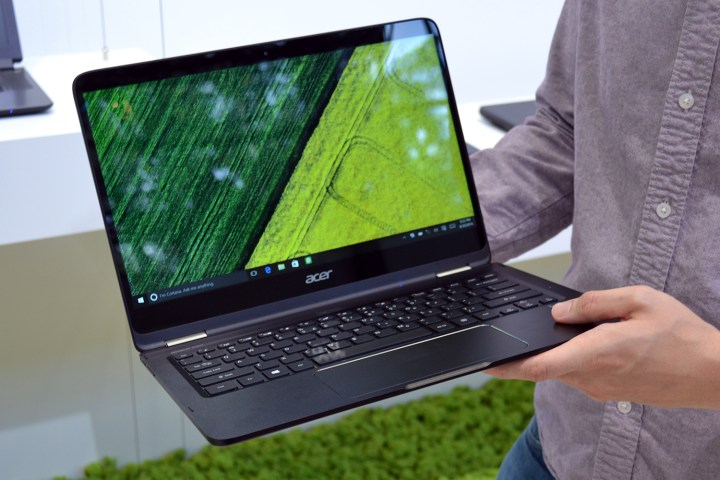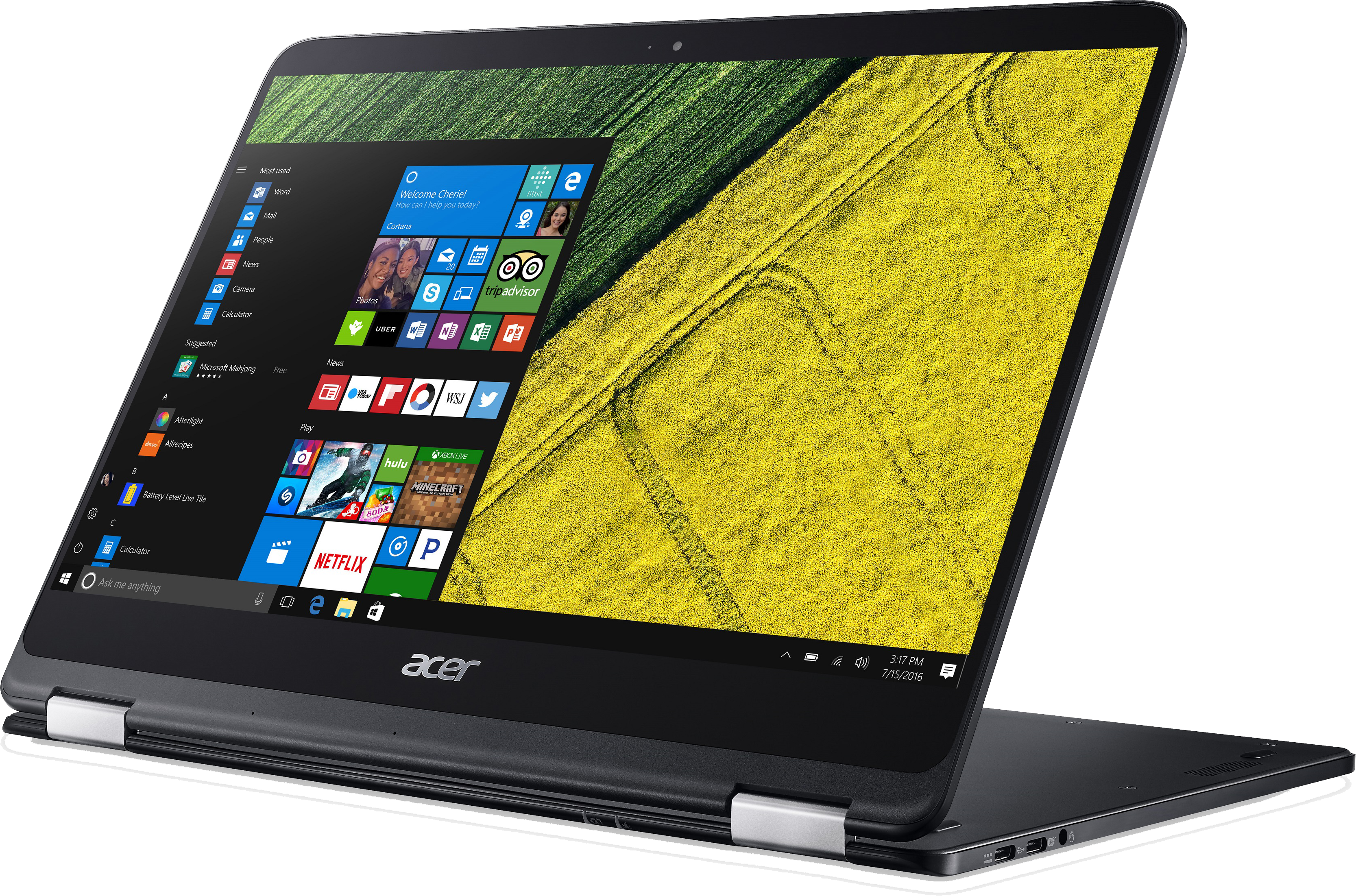
But while Acer undercut Lenovo’s key claim for the Yoga 910 at IFA in Berlin this week, thickness is only one factor. Which convertible laptop is a better bet overall? Here’s a quick comparison that takes into account each model’s official specifications. Stay tuned for full reviews.
Specs
|
Lenovo Yoga 910  |
Acer Spin 7  |
|
| Dimensions | 12.72 x 8.84 x 0.56 (in) | 12.78 x 9.04 x 0.43 (in) |
| Weight | 3.04 pounds | 2.65 pounds |
| Keyboard | Full keyboard with backlight | Full keyboard with backlight |
| Processor | Up to Intel Core i7-7500u | Intel Core i7-7Y75 |
| RAM | Up to 16GB | 8GB LPDDR3 |
| Graphics | Intel HD Graphics | Intel HD Graphics 615 |
| Display | 13.9-inch IPS display | 14-inch FHD IPS display |
| Resolution | 3840 by 2160 pixels or 1920 by 1080 pixels |
1920 by 1080 pixels |
| Storage | 256GB SSD | Up to 1TB SSD |
| Networking | 802.11ac | 802.11ac MU-MIMO |
| Ports | 1 x USB type-C 3.0 with video out 1x USB type-C 2.0 with charging 1 x USB 3.0 with always-on Charing audio combo jack 4-in-1 Card reader |
2 x USB type-C 3.1 Audio jack |
| Operating System | Windows 10 | Windows 10 |
| Battery | Up to 15.5 hours of battery life | Up to 8 hours of battery life |
| Price | Starts at $1,300 | $1,200 |
| Availability | October 2016 | October 2016 |
| Review | Coming soon | Hands-on |
Acer’s Spin 7 offers an Intel Core i7-7Y75. This “Y” series chip is essentially Intel’s 7th-generation replacement for the Core M line. The chip is designed for portable devices, and as such, it uses less energy at the cost of performance. Lenovo, meanwhile, offers a i7-7500U processor, which is a 7th-generation upgrade to the Core i7. This means Lenovo beats Acer on pure processing power.
Things are similar when it comes to memory. Lenovo offers up to 16GB of RAM with the Yoga 910, while Acer simply offers 8GB with the Spin 7. So, if you’re willing to pay for it, the Yoga 910 offers more memory.
Storage works the same way. The Acer Spin 7 offers 256GB of SSD storage, while the Lenovo’s offering provides up to 1TB of solid state storage. We shudder to think what an entire terabyte of solid state storage would add to the price, but it is available if you want it.
In a nutshell, the Spin 7 offers a great set of specs at a relatively low price-point. If you’re willing to pay more, however, Lenovo’s Yoga 910 can beat it across the board.
Display
We don’t have a lot to go on when making a display comparison, well, other than what the companies are telling us. We can say that both laptops offer IPS, touchscreen displays, and that the Yoga 910 is available in more configurations.

The Acer Spin 7 offers 1,920 by 1,080-pixel resolution, which is full HD. The Lenovo Yoga 910 is available with the same resolution, but if you’re willing to pay more, it comes in a configuration that touts 3,840 by 2,160-pixel resolution.
We can’t speak to the quality of the displays without a proper review, but based on numbers alone, Lenovo has the edge if you’re willing to pay for higher pixel density.
Winner: Yoga 910
Portability
At 2.65 pounds, the Acer Spin 7 is lighter than the 3.04-pound Yoga 910 — it’s also slightly thinner at 0.43 inches. To be clear, both of these are absurdly thin for a 2-in-1. Acer has the edge here, but they’re both nearly thin enough that we can imagine actually using them as tablets.
When it comes to battery life, it’s hard to do a direct comparison, because we only have Acer’s and Lenovo’s words to go by. Having said that, Lenovo claims 15.5 hours of battery life for the Yoga 910, while Acer only claims 8 hours of battery life for the Spin 7.
Real figures will vary. However, Lenovo has told us the 910 has a huge 66 watt-hour battery, which could make excellent battery life a reality. You’ll need it, though, if you opt for the 4K screen, which will suck more juice than any 1080p panel.
Without conducting our own battery tests, though, we’ve got to hand portability over to Acer’s Spin 7. It’s thinner and lighter.
Winner: Acer Spin 7
Connectivity
Acer opted to only offer USB type-C ports on the Spin 7, which helped the company keep everything thin. This is going to cause headaches for anyone who wants to plug in a thumb drive, or pretty much any USB device built before this year. A bundled adapter will help things, sure, but it’s a dongle users will need to keep track of. Both ports offer USB 3.1 speeds.
Lenovo’s Yoga 910, on the other hand, also offers two USB type-C ports, one offering 3.0 speeds with video out and another offering USB 2.0 speeds with charging. But thumb drives and other legacy USB devices will also work, thanks to an additional USB type-A port. You can plug your mouse or thumb drive in here, without a dongle. The Yoga 910 also offers a 4-in-1 card reader, which the Spin 7 does not.
The Yoga 910 can connect to more things, but the Acer Spin 7 offers faster transfer speeds. Considering most of the devices you plug into either laptop won’t benefit much from those speeds, we have to give the edge to Lenovo here, if only because most users aren’t ready for a world without USB type-A.
Winner: Yoga 910
Design
These are both beautiful devices with some unique touches. The hinge on the Yoga 910 looks downright otherworldly, in the best way possible, and features series of metal cylinders that resemble a fancy wristband in the way they bend. The result is striking, and Lenovo offers the 2-in-1 in two distinct colors (silver, gunmetal), both of which look great.

The Acer Spin 7, meanwhile, opts for a more understated look. The back of the display is black, while the chassis is gold, which we think is a sharp combination. The design also seems to exaggerate the thinness, with curves everywhere but where the USB ports are.
It’s hard to say which design looks better, but if we have to choose, we’d give the edge to Lenovo and its unique hinge.
Winner: Yoga 910
Availability and price
Both of these laptops will be available in October, though we don’t know an exact date for either. The Acer Spin 7 will cost $1,200, while the Lenovo Yoga 910 starts at $1,300. This means that the cheapest version of the Yoga 910 costs $100 more than the Acer Spin 7.
Winner: Spin 7
Conclusion
Both of these systems are strong contenders, but we have to give the nod to Lenovo’s model. It’s not as light or thin, but it’s no heavyweight — and it’s more powerful, with a wider range of options, including a 4K display, The Yoga also has a huge battery. Given there’s only a $100 price difference between the Spin 7 and the Yoga 910, we have to give Lenovo’s 2-in-1 the win.
Winner: Yoga 910
Editors' Recommendations
- Best Lenovo laptop deals: Save on Yoga and ThinkPad laptops
- The best monitors of CES 2021: HDMI 2.1, OLED, and more
- Acer’s 5G Spin 7 is the world’s first laptop powered by the Snapdragon 8cx Gen 2
- Dell Latitude 7400 2-in-1 vs. ThinkPad X1 Yoga
- The Lenovo ThinkPad X1 Yoga is $420 off for Memorial Day



